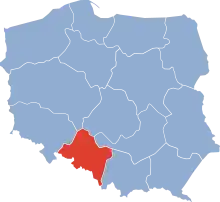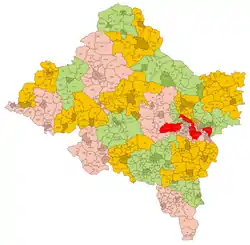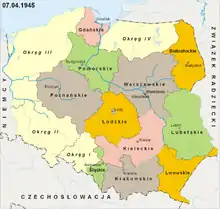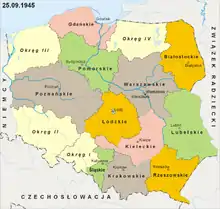Silesian Voivodeship (1945–1950)
The Silesian Voivodeship,[lower-alpha 1][1] also known as the Basin–Silesian Voivodeship,[lower-alpha 2][2] and the Silesian–Dąbrowa Voivodeship,[lower-alpha 3][3] was a voivodeship (province) of Poland, with capital in Katowice, that existed from 1945 to 1950. It was located in the Upper Silesia. The voivodeship was established in 1945 and until 28 June 1945, remained under the administration of the Provisional Government of the Republic of Poland,[4] which then was replaced by the Provisional Government of National Unity.[5] On, 19 February 1947, the provisional government was replaced by the Polish People's Republic.[6] On 28 June 1946, the District of Opolian Silesia had been incorporated into the voivodeship.[7] It existed until 6 July 1950, when it was partitioned into the voivodeships of Katowice and Opole.[8]
| Silesian Voivodeship | |||||||||||||
|---|---|---|---|---|---|---|---|---|---|---|---|---|---|
| Voivodeship of Poland | |||||||||||||
| 1945–1950 | |||||||||||||
 Location of the Silesian Voivodeship within Poland, from 1946 to 1950. | |||||||||||||
| Capital | Katowice | ||||||||||||
| Area | |||||||||||||
• 1947 | 15,369 km2 (5,934 sq mi) | ||||||||||||
| Population | |||||||||||||
• 1946 | 2 800 000 | ||||||||||||
• 1949 | 3 200 000 | ||||||||||||
| History | |||||||||||||
| Government | |||||||||||||
| • Type | Voivodeship | ||||||||||||
| Voivode | |||||||||||||
• 1945 (first) | Jerzy Ziętek | ||||||||||||
• 1948–1950 (last) | Bolesław Jaszczuk | ||||||||||||
| History | |||||||||||||
• Established | 1945 | ||||||||||||
• Incorporation of the District of Opolian Silesia | 28 June 1946 | ||||||||||||
• Partition into the voivodeships of Katowice and Opole | 6 July 1950 | ||||||||||||
| Contained within | |||||||||||||
| • Country | |||||||||||||
| |||||||||||||
History
On 22 August 1944, the Provisional Government of the Republic of Poland signed the resolution, that re-established the administrative subdivisions of the Second Republic of Poland, that existed until 1939, prior to the invasion of Poland by Nazi Germany. As such, the voivodeship had been established in early 1945, within the borders of the Silesian Voivodeship of the Second Polish Republic, that existed from 1920 to 1939. It was formed from the territory of the Province of Upper Silesia, occupied by the Red Army of the Soviet Union. Its capital was located in the city of Katowice.[9][2] Until 28 June 1945, it remained under the administration of the Provisional Government of the Republic of Poland,[4] which then was replaced by the Provisional Government of National Unity.[5] On 19 February 1947, the provisional government was replaced by the Polish People's Republic.[6]
It inherited the status of the autonomous administrative division from its predecessor, the pre-war Silesian Voivodeship, via the Organic Statute of the Silesian Voivodeship. Its autonomy had been revoked on 7 May 1945.[10] On 18 August 1945, it incorporated the counties of Będzin and Zawiercie, from the Kielce Voivodeship.[11] On 28 June 1946, the District of Opolian Silesia had been incorporated into the voivodeship. This included the land counties of Bytom, Dobrodzień, Gliwice, Głubczyce, Grodków, Kluczbork, Koźle, Niemodlin, Nysa, Olesno, Opole, Prudnik, Pszczyna, Racibórz, and Strzelce, and the city counties of Bytom, Gliwice, and Zabrze.[7] The newly incorporated area had been administrated via a government office in Opole.[12] In 1947, it had an area of 15 369 km2.[13]
The voivodeship existed until 6 July 1950, when it was partitioned into the voivodeships of Katowice and Opole.[8]
Subdivisions

The voivodeship was divided into counties. Those were:
- Będzin County (seat: Będzin);
- Bielsko County (seat: Bielsko);
- Bytom (city county; 1946–1950);
- Bytom County (seat: Bytom; 1946–1950);
- Chorzów (city county);
- Cieszyn County (seat: Cieszyn);
- Dobrodzień County (seat: Dobrodzień; 1946–1950);
- Gliwice (city county; 1946–1950);
- Gliwice County (seat: Gliwice; 1946–1950);
- Głubczyce County (seat: Głubczyce; 1946–1950);
- Grodków County (seat: Grodków; 1946–1950);
- Katowice (city county);
- Katowice County (seat: Katowice);
- Kluczbork County (seat: Kluczbork; 1946–1950);
- Koźle County (seat: Koźle; 1946–1950);
- Lubliniec County (seat: Lubliniec);
- Niemodlin County (seat: Niemodlin; 1946–1950);
- Nysa County (seat: Nysa; 1946–1950);
- Olesno County (seat: Olesno; 1946–1950);
- Opole County (seat: Opole; 1946–1950);
- Prudnik County (seat: Prudnik; 1946–1950);
- Pszczyna County (seat: Pszczyna);
- Racibórz County (seat: Racibórz; 1946–1950);
- Rybnik County (seat: Rybnik);
- Sosnowiec (city county);
- Strzelce County (seat: Strzelce Opolskie; 1946–1950);
- Tarnowskie Góry County (seat: Tarnowskie Góry);
- Zabrze (city county; 1946–1950);
- Zawiercie County (seat: Zawiercie).
Leaders
The leader of the voivodeship was the voivode.[16] The people in that office were:
- 1 February 1945 – 10 March 1945: Jerzy Ziętek;
- 14 March 1945 – 31 October 1948: Aleksander Zawadzki;
- 1 November 1948 – 13 June 1950: Bolesław Jaszczuk.
Gallery
 The administrative subdivisions of Poland in April 1945, including the Silesian Voivodeship.
The administrative subdivisions of Poland in April 1945, including the Silesian Voivodeship. The administrative subdivisions of Poland in September 1945, including the Silesian Voivodeship.
The administrative subdivisions of Poland in September 1945, including the Silesian Voivodeship.
Citations
Notes
References
- Okólnik nr 11 Prezesa Rady Ministrów z dnia 9 maja 1949 r. w sprawie nazw Województw.
- Gazeta Urzędowa Województwa Śląskiego, no. 1, 27 February 1945, Katowice.
- "This Day in History: 1945-03-11". instytutslaski.pl.
- Paweł Wieczorkiewicz: Historia polityczna Polski 1935–1945, Warsaw: Książka i Wiedza publishing house, 2005. ISBN 83-05-13441-5, p. 459.
- Aleksander Gella: Zagłada Drugiej Rzeczypospolitej 1945–1947, Warsaw, 1998.
- Andrzej Ajnenkiel: Polskie konstytucje. Warsaw: Wiedza Powszechna. 1983. ISBN 83-214-0256-9.
- Rozporządzenie Rady Ministrów z dnia 29 maja 1946 r. w sprawie tymczasowego podziału administracyjnego Ziem Odzyskanych.
- Ustawa z dnia 28 czerwca 1950 r. o zmianach podziału administracyjnego Państwa.
- Ustawa z dnia 28 maja 1975 r. o dwustopniowym podziale administracyjnym Państwa oraz o zmianie ustawy o radach narodowych.
- Ustawa Konstytucyjna z dnia 6 maja 1945 r. o zniesieniu statutu organicznego województwa śląskiego.
- Dekret z dnia 7 lipca 1945 r. o zmianie granic województw: śląskiego, krakowskiego, kieleckiego, białostockiego i warszawskiego.
- Rozporządzenie Rady Ministrów z dnia 29 maja 1946 r. w sprawie powołania ekspozytur urzędów wojewódzkich na obszarze Ziem Odzyskanych.
- Rocznik Statystyczny 1947. Warsaw: Central Statistical Office, 1947.
- Ryszard Kaczmarek: Historia Górnego Śląska. Polityka, gospodarka i kultura europejskiego regionu. Dom Współpracy Polsko-Niemieckiej, 2011, p. 40. ISBN 978-83-60470-41-1.
- Bernard Linek, Adam Dziurok: Historia Górnego Śląska. Polityka, gospodarka i kultura europejskiego regionu. Dom Współpracy Polsko-Niemieckiej, 2011, p. 272-273. ISBN 978-83-60470-41-1.
- "Voivodeships of Poland 1945-1975 and 1999-". worldleadersindex.org. Archived from the original on 4 August 2014.
